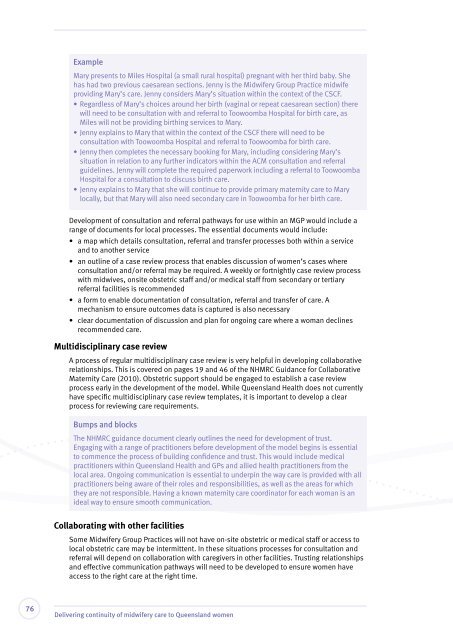Delivering continuity of midwifery care to Queensland women
Delivering continuity of midwifery care to Queensland women
Delivering continuity of midwifery care to Queensland women
You also want an ePaper? Increase the reach of your titles
YUMPU automatically turns print PDFs into web optimized ePapers that Google loves.
Example<br />
Mary presents <strong>to</strong> Miles Hospital (a small rural hospital) pregnant with her third baby. She<br />
has had two previous caesarean sections. Jenny is the Midwifery Group Practice midwife<br />
providing Mary’s <strong>care</strong>. Jenny considers Mary’s situation within the context <strong>of</strong> the CSCF.<br />
• Regardless <strong>of</strong> Mary’s choices around her birth (vaginal or repeat caesarean section) there<br />
will need <strong>to</strong> be consultation with and referral <strong>to</strong> Toowoomba Hospital for birth <strong>care</strong>, as<br />
Miles will not be providing birthing services <strong>to</strong> Mary.<br />
• Jenny explains <strong>to</strong> Mary that within the context <strong>of</strong> the CSCF there will need <strong>to</strong> be<br />
consultation with Toowoomba Hospital and referral <strong>to</strong> Toowoomba for birth <strong>care</strong>.<br />
• Jenny then completes the necessary booking for Mary, including considering Mary’s<br />
situation in relation <strong>to</strong> any further indica<strong>to</strong>rs within the ACM consultation and referral<br />
guidelines. Jenny will complete the required paperwork including a referral <strong>to</strong> Toowoomba<br />
Hospital for a consultation <strong>to</strong> discuss birth <strong>care</strong>.<br />
• Jenny explains <strong>to</strong> Mary that she will continue <strong>to</strong> provide primary maternity <strong>care</strong> <strong>to</strong> Mary<br />
locally, but that Mary will also need secondary <strong>care</strong> in Toowoomba for her birth <strong>care</strong>.<br />
Development <strong>of</strong> consultation and referral pathways for use within an MGP would include a<br />
range <strong>of</strong> documents for local processes. The essential documents would include:<br />
• a map which details consultation, referral and transfer processes both within a service<br />
and <strong>to</strong> another service<br />
• an outline <strong>of</strong> a case review process that enables discussion <strong>of</strong> <strong>women</strong>’s cases where<br />
consultation and/or referral may be required. A weekly or fortnightly case review process<br />
with midwives, onsite obstetric staff and/or medical staff from secondary or tertiary<br />
referral facilities is recommended<br />
• a form <strong>to</strong> enable documentation <strong>of</strong> consultation, referral and transfer <strong>of</strong> <strong>care</strong>. A<br />
mechanism <strong>to</strong> ensure outcomes data is captured is also necessary<br />
• clear documentation <strong>of</strong> discussion and plan for ongoing <strong>care</strong> where a woman declines<br />
recommended <strong>care</strong>.<br />
Multidisciplinary case review<br />
A process <strong>of</strong> regular multidisciplinary case review is very helpful in developing collaborative<br />
relationships. This is covered on pages 19 and 46 <strong>of</strong> the NHMRC Guidance for Collaborative<br />
Maternity Care (2010). Obstetric support should be engaged <strong>to</strong> establish a case review<br />
process early in the development <strong>of</strong> the model. While <strong>Queensland</strong> Health does not currently<br />
have specific multidisciplinary case review templates, it is important <strong>to</strong> develop a clear<br />
process for reviewing <strong>care</strong> requirements.<br />
Bumps and blocks<br />
The NHMRC guidance document clearly outlines the need for development <strong>of</strong> trust.<br />
Engaging with a range <strong>of</strong> practitioners before development <strong>of</strong> the model begins is essential<br />
<strong>to</strong> commence the process <strong>of</strong> building confidence and trust. This would include medical<br />
practitioners within <strong>Queensland</strong> Health and GPs and allied health practitioners from the<br />
local area. Ongoing communication is essential <strong>to</strong> underpin the way <strong>care</strong> is provided with all<br />
practitioners being aware <strong>of</strong> their roles and responsibilities, as well as the areas for which<br />
they are not responsible. Having a known maternity <strong>care</strong> coordina<strong>to</strong>r for each woman is an<br />
ideal way <strong>to</strong> ensure smooth communication.<br />
Collaborating with other facilities<br />
Some Midwifery Group Practices will not have on-site obstetric or medical staff or access <strong>to</strong><br />
local obstetric <strong>care</strong> may be intermittent. In these situations processes for consultation and<br />
referral will depend on collaboration with <strong>care</strong>givers in other facilities. Trusting relationships<br />
and effective communication pathways will need <strong>to</strong> be developed <strong>to</strong> ensure <strong>women</strong> have<br />
access <strong>to</strong> the right <strong>care</strong> at the right time.<br />
76<br />
<strong>Delivering</strong> <strong>continuity</strong> <strong>of</strong> <strong>midwifery</strong> <strong>care</strong> <strong>to</strong> <strong>Queensland</strong> <strong>women</strong>
















